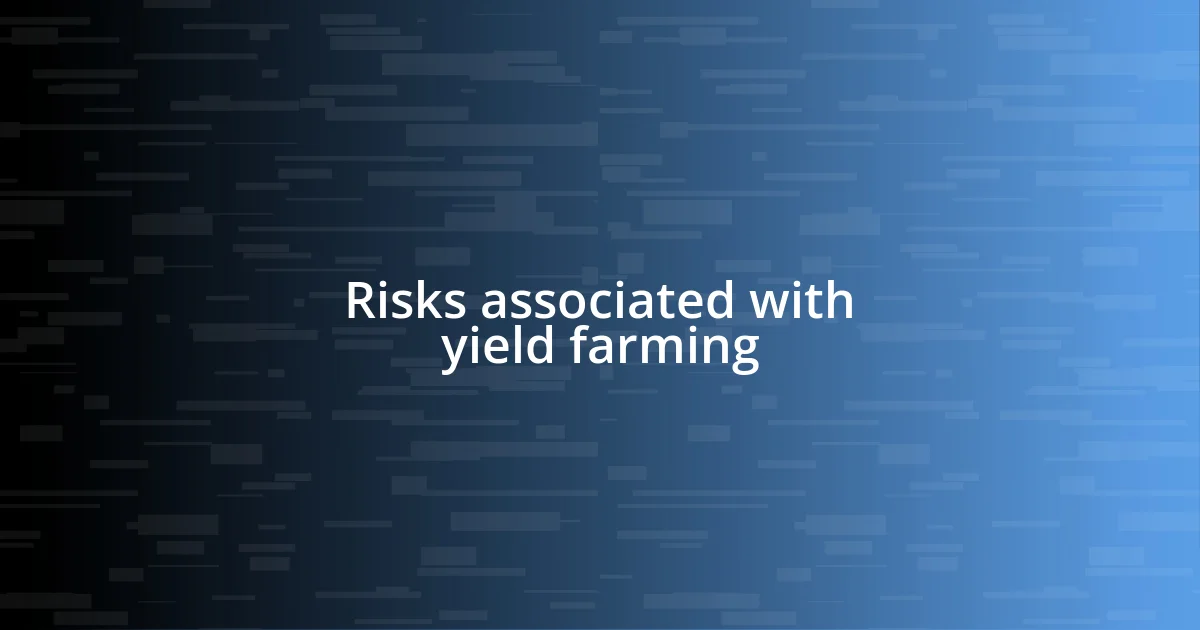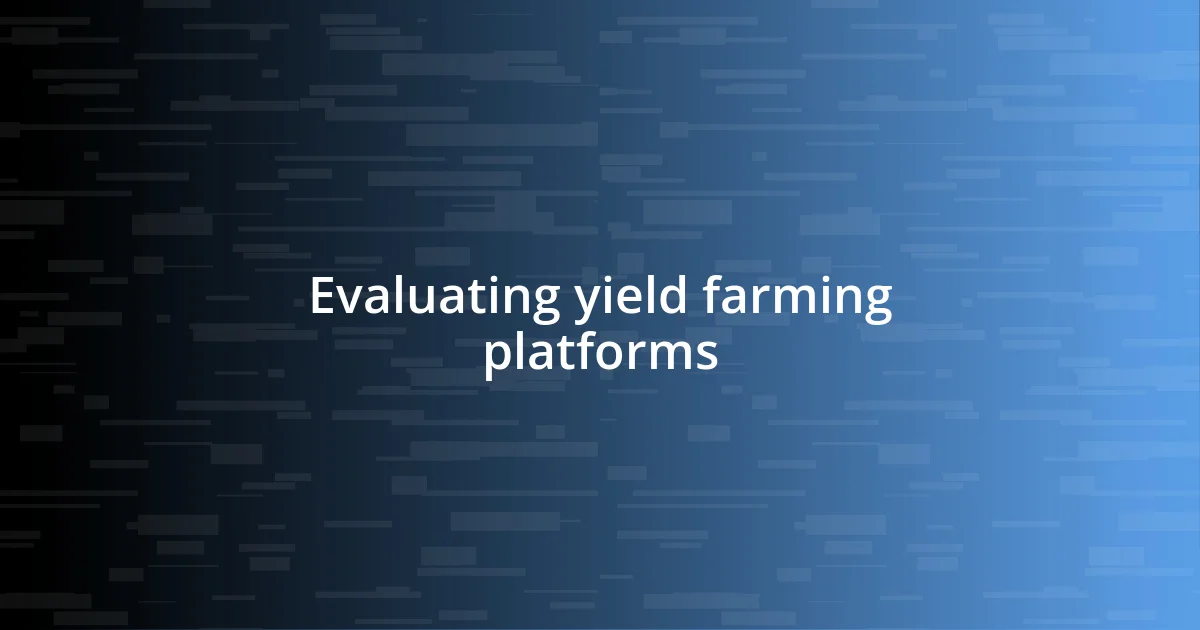Key takeaways:
- Stablecoin yield farming offers the potential for passive income but involves risks such as impermanent loss and smart contract vulnerabilities.
- Diversification across platforms, thorough research, and monitoring market trends are essential strategies for effective yield farming.
- Evaluate platforms based on reputation, security features, and historical performance to ensure safe and profitable investments.

What is stablecoin yield farming
Stablecoin yield farming is a method where users lend or stake stablecoins in return for interest or other rewards, typically in the form of cryptocurrencies. It combines the stability of coins like USDC or DAI with the potential for higher returns, which can be quite appealing. I remember the first time I engaged in it—I was both excited and anxious, wondering if I was stepping into a goldmine or just another trap.
The beauty of stablecoin yield farming lies in its duality: on one hand, it offers the promise of earning passive income, while on the other, there are innate risks involved that can leave you feeling uneasy. Have you ever held a stablecoin and thought, “What if I could make it work for me?” That’s the essence of yield farming—taking a supposedly stable asset and letting it generate returns, sometimes significantly more than traditional savings accounts.
In the world of decentralized finance (DeFi), many platforms allow you to stake your stablecoins, but not all are created equal. I recall a moment of decision when I evaluated various platforms; the differences in potential yields and safety measures were eye-opening. That experience taught me to always do thorough research and factor in not just the returns but the security of my assets as well.

Strategies for effective yield farming
When it comes to yield farming, I’ve found that diversification is key. Just as in traditional investments, spreading your stablecoins across different platforms can help mitigate risks while maximizing potential returns. I remember splitting my funds between a couple of lending platforms—this not only boosted my overall yield but also provided a safety net. If one platform faced issues, I wouldn’t be left high and dry.
Here are some effective strategies for yield farming:
- Research Thoroughly: Always dive into the fundamentals of each platform. Understand their liquidity pools, how they generate returns, and their security protocols.
- Start Small: I began with a modest investment, gradually increasing it as I gained confidence in the platform’s credibility.
- Monitor Market Trends: Keep an eye on changing interest rates and terms, as these can significantly impact your returns.
- Set Your Risk Threshold: Evaluate how much risk you’re willing to take. Adjust your strategies accordingly to align with your tolerance.
- Reinvest Rewards: I found that piling up my earnings and reinvesting them typically supercharged my yield over time.
Balancing these strategies helped me cultivate a steady income stream while maintaining a logical approach to risk management.

Risks associated with yield farming
The allure of yield farming can sometimes overshadow the inherent risks. I remember the gut-wrenching feeling when I learned about impermanent loss. This occurs when the value of the tokens in a liquidity pool changes compared to simply holding them. I once faced this reality. After I had staked a decent amount of my stablecoins, I noticed a significant dip in value, leading to a realization that the rewards were not worth the loss in capital value. Overall, it’s crucial to understand that while you may see enticing yields, market fluctuations can diminish those gains dramatically.
Additionally, smart contract vulnerabilities are another concern that I learned the hard way. Despite the glittering promise of DeFi, platforms are powered by smart contracts that can be susceptible to bugs or hacks. I still vividly remember hearing about a project I was involved with being exploited, resulting in significant losses for many users. My lesson was clear: always prioritize security audits and transparency from the platforms you choose. It’s not enough to just chase high yields; ensuring your assets are secure should be equally paramount.
Lastly, regulatory risks can also cloud the yield farming landscape. As I became more involved, I began to realize how rapidly regulations can shift, leading to uncertainty. I recall contemplating a new platform only to discover it was under scrutiny from authorities, which raised concerns for me. It reminded me to remain aware of the evolving regulatory landscape and how it might impact my investments in yield farming.
| Risk Type | Description |
|---|---|
| Impermanent Loss | Loss incurred when the price of staked tokens changes compared to holding them directly. |
| Smart Contract Vulnerabilities | Potential bugs or exploits within the code that could lead to loss of funds. |
| Regulatory Risks | Changes in laws that might affect the viability of platforms or reduce yields. |

Maximizing returns with yield farming
To truly maximize returns with yield farming, I discovered the importance of timing my entries and exits. I remember feeling the rush after observing a platform’s yield spiking due to increased liquidity attraction. It was a pivotal moment when I realized that timing wasn’t just about market movements but also about understanding when to jump into new opportunities or pull out my investments. Have you ever sat on the sidelines, watching yields soar, wondering if you missed your chance? It’s a common feeling, but being proactive and informed can make all the difference.
Another strategy that significantly boosted my returns was leveraging incentives offered by platforms. Some platforms have attractive bonus structures for early adopters or for those who lock in their funds for longer durations. I once participated in a limited-time promotional yield farm, and the returns I earned during that period were quite remarkable. If you’re given the opportunity, why not dive in headfirst? Just remember to weigh the commitment against the risk.
Lastly, I found that actively engaging with the community around projects provided insights that could shape my yield farming strategy. I often joined forums and Telegram groups where experiences and tips flowed freely. This network was invaluable; I learned about upcoming changes in protocols or potential yield adjustments before they were widely announced. Have you tapped into the collective knowledge of other farmers? Connecting with others in this space can be like having a roadmap in the chaotic landscape of DeFi, guiding you toward those sweet, maximized returns.

Evaluating yield farming platforms
When evaluating yield farming platforms, I’ve learned that not all platforms are created equal. One of my biggest takeaways was to investigate the platform’s reputation and user feedback before committing my funds. I remember visiting a platform that looked appealing at first glance but soon found numerous complaints from users regarding slow transaction speeds and unresponsive support. It’s a stark reminder that doing thorough research can save you from frustrating and costly mistakes.
Security features are another paramount aspect that I’ve come to prioritize. Early on, I neglected to check how a platform managed its security protocols, and I suffered the consequences. I still recall the sinking feeling I had when I discovered that the project I had invested in had a lackluster audit history. Now, I always check for third-party audits and community trust scores. Are the developers transparent about their practices? If not, it’s a red flag that I pay close attention to.
Lastly, looking into the platform’s historical performance and how it reacts to market fluctuations has become a fundamental part of my evaluation process. Not long ago, I analyzed a platform that boasted high yields but had a history of failing during market downturns. Each time the market dipped, so did user confidence, leading to a rapid withdrawal of funds and plummeted yields. Have you ever invested in a platform just to watch it crumble in tough times? Making sure that a platform has resilience under stress is now something I won’t compromise on.














